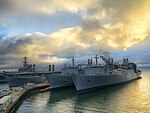USS Hornet Museum

The USS Hornet Museum is a museum ship, located on the southernmost pier of the former Naval Air Station Alameda in Alameda, California, US. The museum is composed of the aircraft carrier USS Hornet, exhibits from the NASA Apollo Moon exploration missions, and several retired aircraft from the Second World War and the transonic and early supersonic jet propulsion period. A number of compartments contain exhibits concerning contemporary carriers that are supported by related associations. The flight deck, hangar deck, and first deck below are open for self-guided tours. Docent-led tours are available into the ship's navigation and flight deck control areas of the island and down into one of the engineering spaces containing two of the four ship's propulsion turbines.
Excerpt from the Wikipedia article USS Hornet Museum (License: CC BY-SA 3.0, Authors, Images).USS Hornet Museum
Pier 3,
Geographical coordinates (GPS) Address Website Nearby Places Show on map
Geographical coordinates (GPS)
| Latitude | Longitude |
|---|---|
| N 37.772541666667 ° | E -122.30284166667 ° |
Address
USS Hornet (CV 12)
Pier 3
94607
California, United States
Open on Google Maps






